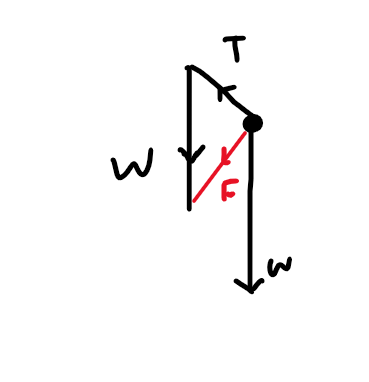Question
A stuntman rides a motorcycle on the inside surface of a cylinder.

Which is the correct free-body diagram showing all the forces acting on the cyclist at that position?

▶️Answer/Explanation
Ans:C

Question
A ball attached to a string is made to rotate with constant speed along a horizontal circle. The string is attached to the ceiling and makes an angle of \(\theta^{\circ}\) with the vertical. The tension in the string is \(T\).

What is correct about the horizontal component and vertical component of the net force on the ball?

▶️Answer/Explanation
Ans:D

From FBD we can say option D is correct net force in vertical must be zero as it is rotating in along a horizontal circle.
Question
A block of mass 2.0kg is placed on a trolley of mass 5.0kg, moving horizontally. A force of 8.0N is applied to the block which slides on the surface of the trolley. The frictional force between the trolley and the ground is zero.

The trolley accelerates at a rate of \(1.0 \mathrm{~m} \mathrm{~s}^{-2}\). What is the coefficient of dynamic friction between the block and the trolley?
A. \( 0.05\)
B. \( 0.15\)
C. \( 0.25\)
D. \( 0.35\)
▶️Answer/Explanation
Ans:C

friction $= 5\times 1=5~\rm N$
$\mu _k (2 \times 10) =5$
$\mu=\frac{1}{4}$
Question
A mass is suspended by a light string from the roof of a car. The car is accelerating up an incline.

What is the free-body diagram for the mass?

▶️Answer/Explanation
Ans:B

So only B and C option Possible ,
IN , B $F_{net}$ is in correct direction

In C, direction of F net is not in correct direction

Question
The angle \(\theta\) between a ramp and a horizontal surface slowly increases from zero. An object on the ramp does not slide as \(\theta\) increases.

The frictional force on the object is
A. constant.
B. negligible.
C. proportional to \(\cos \theta\).
D. proportional to \(\sin \theta\).
▶️Answer/Explanation
Ans:D

As, block does not slide so Friction will be equal to pulling force
$f=mg sin\theta $
$f\propto \sin \theta$